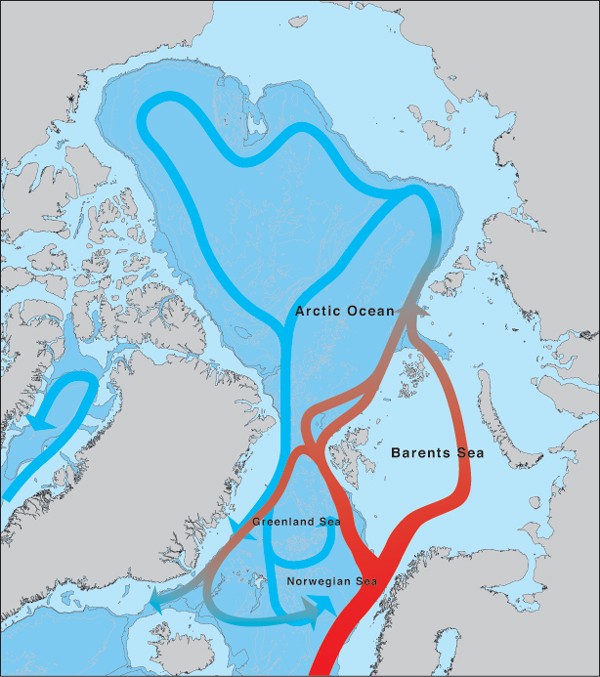The sea and ocean currents
It is said that the sea is the world's biggest breadbasket, but for the staff in Arctic Ltd it is infinitely more – a delivery room, a playpen, a means of conveyance and a workplace. Most of the production takes place in the sea, and it is the sea that forms the basis for the firm's wealth creation.
The sunlight goes some way towards heating the Arctic, but heat also comes from the south with ocean currents and airstreams. One branch of the Gulf Stream, called the North Atlantic Current, flows along the coast of Norway and continues all the way to the Arctic Ocean. There it shifts its name to the West Spitsbergen Current, and almost 60 % of the water entering the Arctic Ocean comes with this. Even though the currents change their name as they move north, they are all part of the same system, which is an exten-sion of the Gulf Stream.
However, some water also flows in through the Bering Strait and some fresh water enters from the big Russian and Canadian rivers, which explains why the topmost 45 metres of the Arctic Ocean are less saline than the water below.
The Fram Strait between Greenland and Svalbard is therefore the major arterial route for seawater to and from the polar area. Warm Atlantic Ocean water flows north along the west coast of Svalbard, and cold water flows south along the coast of East Greenland, and also out into the Barents Sea along the east side of Svalbard.
The area of the Barents Sea where the cold, relatively fresh, Arctic water meets the warm, saline Atlantic water is called the polar front. The polar front does not lie in a specific geographical position, but may move somewhat from year to year.
Did you know...
 The predominant wind direction over the Arctic Ocean rotates the surface water in a large circle, called the Beaufort Gyre, which makes the polar ice move slowly in the same direction, too. Sea ice that lies close to the centre of the gyre can complete a full 360° circle in a matter of 2 years, but that which is furthest from the centre requires 7–8 years to complete the same circle. In addition to the Beaufort Gyre, the surface circulation in the Arctic Ocean is dominated by the Transpolar Drift, which consists of wind and ocean currents that cross the entire ocean from Siberia to exit through the Fram Strait. Fridtjof Nansen discovered this drift and proved its existence by allowing his ship, the Fram, to freeze into the ice by the New Siberian Islands in 1893. It escaped the grip north of Svalbard in 1896, almost 3 years later.
The predominant wind direction over the Arctic Ocean rotates the surface water in a large circle, called the Beaufort Gyre, which makes the polar ice move slowly in the same direction, too. Sea ice that lies close to the centre of the gyre can complete a full 360° circle in a matter of 2 years, but that which is furthest from the centre requires 7–8 years to complete the same circle. In addition to the Beaufort Gyre, the surface circulation in the Arctic Ocean is dominated by the Transpolar Drift, which consists of wind and ocean currents that cross the entire ocean from Siberia to exit through the Fram Strait. Fridtjof Nansen discovered this drift and proved its existence by allowing his ship, the Fram, to freeze into the ice by the New Siberian Islands in 1893. It escaped the grip north of Svalbard in 1896, almost 3 years later.
 The paths of ocean currents in the Arctic. The Gulf Stream, carrying warm Atlantic water, moves northwards along the coast of Norway. It divides into two main branches and continues northwards with one branch on either side of Svalbard. In the Arctic Ocean, the Atlantic water is cooled, becomes heavier and sinks. After circulating in the North Polar Basin, the now cold, Arctic water leaves the Arctic Ocean, mainly through the Fram Strait between Svalbard and Greenland.
The paths of ocean currents in the Arctic. The Gulf Stream, carrying warm Atlantic water, moves northwards along the coast of Norway. It divides into two main branches and continues northwards with one branch on either side of Svalbard. In the Arctic Ocean, the Atlantic water is cooled, becomes heavier and sinks. After circulating in the North Polar Basin, the now cold, Arctic water leaves the Arctic Ocean, mainly through the Fram Strait between Svalbard and Greenland.
Illustration: Audun Igesund, NPI.